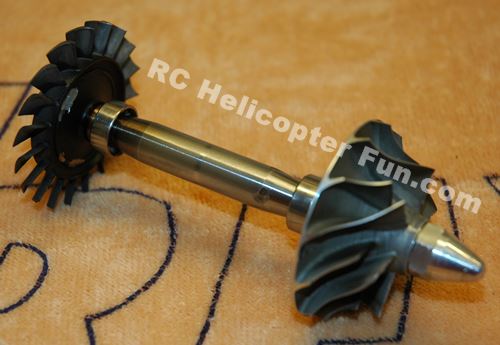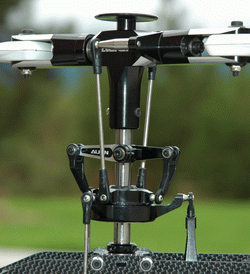Blade mCP S RC Helicopter Review
by John Salt
The Blade mCP in all its versions (X, BL, & S) stands for micro collective pitch.
The "X" first referring to Blade's flybarless designation. The "BL" referring to the brushless version. And then the S version which has "SAFE Technology" (Blade's branded name their self/auto-leveling stabilization system).
 Original X Version
Original X Version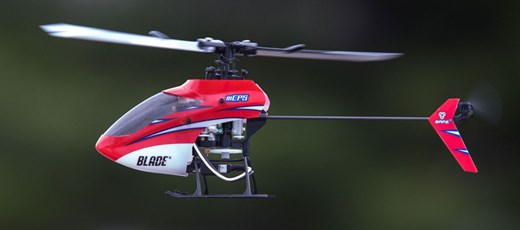 The S Version
The S VersionRC helicopters like the the Blade mCP S have been long time pipe dreams for so many of us collective pitch fliers and to be honest, I never thought a true indoor micro collective pitch heli this small with this much performance would ever be a reality.
For those of you who are just getting into this hobby, you don’t know how fortunate you are.
Just imagine practicing and flying a collective pitch helicopter in your living room safely and economically. From learning the basics right up to more advanced maneuvers with a CP heli that fit's into the palm of your hands. Well, that's exactly what Blade gave us back in 2010 with the very first micro sized CP heli (the mCP X).
Let’s push the obvious fun factor aside for a moment and think of what this really means for so many of us. The potential for quickly improving and gaining new collective pitch flying skills in the comfort of our homes from the very basics up to more advanced flying but actually learning them on something that flies instead of spending time on a RC heli simulator could be considered revolutionary by some. Have a look!
This is the number one reason why I purchased a Blade mCP – to help take my sport flying skills on my larger birds to the next level in a fun and affordable way.
Let’s be honest here, there is no question simulator time is so helpful when learning the orientation reversals and dynamics of aerobatic flight (or any new heli skill for that matter) as our brains wire new pathways so it all becomes automatic as we practice, practice, practice.
The problem is it gets boring, boring, boring; at least that’s how I feel about my time on the simulator and lately, I almost see it as a chore. There’s simply no substitution for real flight time.
Having a little bit of fear and adrenaline rush every now and then coupled with the insane fun is after all why this hobby is so bloody addictive.
The little Blade mCP S has a flying weight of only 1.7oz/49g. The light weight means these little rascals generally just bounce off hard objects and come back fighting just like Blades micro fixed pitch helis such as the mSR.
Now we can have a real collective pitch bird to practice on that will be fairly robust and "goof-proof". Hell, even if we do managed to pile drive the little bugger into something hard enough to fragmentize the main rotors or crack the canopy, what will the repair costs be, $10 to $20 bucks - maybe?
Money aside, what about repair time? Perhaps 5 minutes to replace the entire head assembly and be back flying compared to many hours of rebuild time on a larger collective pitch bird.
The Technology Behind The Blade mCP S
I already covered the low weight, so we know crash survivability
should be on par with the mSR but in reality it is more in line with the
larger
120 S because this little mCP S is running higher head speeds since it’s using symmetrical rotors
instead of the high lift efficient delta rotors used on all the micro
fixed pitch birds.
Flybarless Stabilization
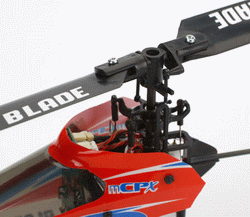
Okay, this was the biggest surprise at how well this very inexpensive AS3X system with SAFE works. Yes the Blade mCP s is utilizing a flybarless head with 3 gyro electronic stabilization - one gyro for tail yaw, and two more to detect and correct for pitch and roll.
SAFE technology adds 3 accelerometer sensors to the mix which allows for self leveling while in SAFE mode.
If you have looked at my Flybarless Page , you know what flybarless is, how it works, and the benefits. The original mCP X was Blade’s first helicopter ever to employ an electronic flybarless stabilization system and as I mentioned, it works flawlessly.
The first thing you will notice if you had the Blade mSR/X or 120SR, or even some of the larger collective pitch Blade helis is tail rotor drift is fairly non existent. The tail hold on the little mCP S is for the most part, absolutely drift free - unless it blows out, and yes it does (more on that later).
The cyclic portion of the flybarless system works equally well in all areas of flight from hovering right up to very fast flying and aerobatics. Yes, these little Blade mCP's scream through the air if you want them to.
With the AS3X in charge, you never have to worry about messing with trim because the flybarless electronic stabilization always keeps the bird in perfect trim. All the common problems associated with micro heli stability, cyclic response, fragile micro flybar linkages, 45 degree flybar pendulum effect, and TBE ( toilet bowl effect ) have been completely eliminated with Blade's AS3X flybarless technology.
With the self-leveling SAFE turned on, the mCP S becomes quite docile, and is not too much harder to pilot than one of Blades fixed pitch SAFE equipped helis such as the mSR S or 120 S. That said, cyclic reaction is faster, so it will "run away" from you quicker and requires more stick finesse.
Of course the other main benefit with a flybarless setup is less weight and less overall drag increasing power and flight times.
Coreless Direct Drive Tail Motor
Like the Blade 70S, mSR, and the 120, the Blade mCP S is using a light weight, efficient, and fast accelerating/decelerating coreless tail motor.
Next to small micro helis with direct drive Brushless tail motors, these are the only RC helicopters I have been pleased with when it comes to decent tail holding using a motor driven fixed pitch tail rotor. The Blade mCP S is no different while performing gentle type flying. The problem however is when you start bouncing between positive and negative pitch while performing aerobatics.
The issues associated with all brushed motorized tails in conjunction with higher collective pitch torque spikes start showing up as the tail loses its battle against the main rotor torque - especially if running larger collective ranges and not managing your collective energy well.
This is when the little mCP S will draw too much power and leave nothing for the tail motor causing the tail to blow out. The rule of the day in other words, is to manage your collective energy by keeping the collective transitions on the mild side and not perform many back to back high rotor loading maneuvers that will bog down the rotor/motor energy.
Tail blow out (TBO) can be anywhere from mild to absolutely out of control. The lower the battery voltage is and the harder you mismanage your collective, the worse it becomes to the point where I won't even try entering inverted flight after about 1.5 minutes of run time.
Blade mCP 3 in 1 Board & Linear Servos
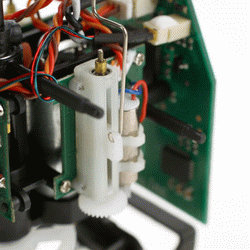
As with all of Blade's micro RC Helicopters, the heart and brains of the heli is the multi function control board which includes the DSM2 receiver circuitry, 3 axis AS3X gyro & accelerometer stabilization system, and the ESC/tail mixer circuitry.
What's different on these Blade micro helis is the (now three) linear servos that manipulate the swashplate are not placed on the main control board but instead are individually placed on the main frame around the main mast to allow for the common 120 degree eCCPM swash configuration.
One would think that in the swash type setup menu, you would select 120 degree mixing; but the flybarless electronic stabilization system performs the electronic mixing so a normal single servo 90 degree swash type must be selected simplifying setup considerably.
The other improvement Blade has made with these new linear servos is to use upper and lower ball bearings on the drive shaft coupled with a longer throw to give improved resolution along with smooth and precise collective & cyclic control and it really is nice.
These little Blade mCP's along with the smaller and more indoor friendly Blade Nano, have the most aggressive and fastest responding cyclic of any micro RC helicopters I have ever owned or flown due in part to the low mass (both heli & rotor disc).
LiPo Batteries & Charger
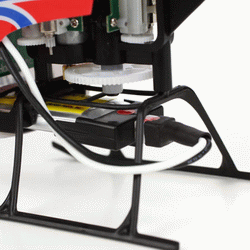
The Blade mCP S comes out of the box with two 210 mAh 1S (single cell 3.7 volt) 40C LiPo batteries. It’s nice Blade decided to package it with two packs, but as most of us electric powered fliers know, that’s not going to be enough, especially considering how fun this heli is.
These LiPo packs give the mRS S a solid 5 minutes of gentle flying but if you fly at full power and are really banging away on the collective, expect 2.5 minutes.
There are of course other aftermarket options, with 300 mAh version being about the largest you can cram into the holster under the belly.
If you are a big fan of Parallel Charging, like I am, there are several boards and harnesses available for that as well.
The LiPo charger included with the Blade mCP S is a cheap and inexpensive USB charger. Nothing fancy or powerful, but it works to get you started.
You can also use E-Flite's Celectra 4-Port 1S Charger which many find very convenient for charging up to 4 battery packs at once.
Blade mCP S Size
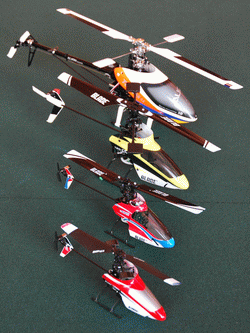
The picture to the left shows in order from bottom to top, the Blade mSR, mCP, 120, and just to include my smallest collective pitch bird (before I got the very tiny mCP) an Align Trex 250.
I figured the Trex 250 may as well be included in the photo since I reference it often in this review comparing the mCP to it numerous times.
How The Blade mCP's Fly:
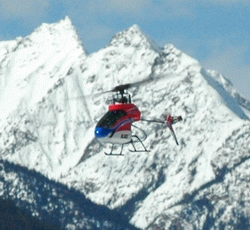
The short answer - very well... It really is a treat to fly something this tiny that is so stable in both fast flight and while hovering.
As I mentioned, it really reminded me of flying my Trex 250 or even more so, my friends 250 3G but with much less power. There are some issues however.
For learning how to fly a collective pitch RC helicopter up to general type flying, it's superb and I know lot of first time collective pitch pilots who have successfully learned the basics very well on the mCP.
It's still my opinion that a larger 450 makes a better trainer when setup as such; but if your budget doesn't allow that or you really want to learn inside your home, the mCP S is a solid choice. What I am most impressed with is how well it hovers in ground effect and that is the key to learning to fly collective pitch on the Blade mCP S.
For those of you with other small micros such as the mSR or 120 S you know how the rotor wash pushes them all over the place when close to the ground rendering control all but impossible - you have to be a good foot or two in the air with those birds before they settle down... right?
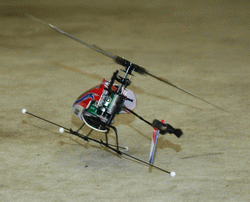 Sliding the Blade mCP around on the ground is as easy a larger bird (less the fear)!
Sliding the Blade mCP around on the ground is as easy a larger bird (less the fear)!Not so with the Blade mCP.
It is able to perform ground movement and low hovering exercises with a set of micro training gear about as well as a 250 size heli (again why I keep coming back to that Trex 250 comparison).
It also does surprisingly well in light wind. Yes it gets tossed around a bit, but not nearly as much as I thought it would. Out of all the micro/ultra micro helis in Blade's hanger, the Blade mCP S takes top marks in the wind handling department thanks to the much higher collective pitch head speeds.
No, it's not as stable as a 450 size or larger bird when in ground effect or a wind, but it's certainly controllable making learning on it from the ground up very possible. Essentially, there is not one lesson in my flight school section that you can't practice with on the mCP S. For that collective pitch learning curve, the Blade mCP S heli is the revolution we were all hoping it would be.
As I mentioned, cyclic response is very crisp and insanely fast (yep, there's no doubt it's flybarless) way too fast for most beginners. However, with SAFE turned on, the right aileron and elevator dual rate settings and a little EXPO, you can really tame that aggressive cyclic down to the point it feels "beginner comfortable" which I do cover in the micro setup section of my Setup & Tips ebook .
Docile pitch curves are also very workable on the mCP S and I used the same "guesstimated" beginner pitch values on the Blade mCP's as I use on all my collective pitch birds with very good "tamed down" results.
I say guesstimated since there is no way to check the actual collective pitch readings because there are no pitch gauges small enough but I show how to build a very simple wedge gauge in the setup & tips ebook that will get you very close.
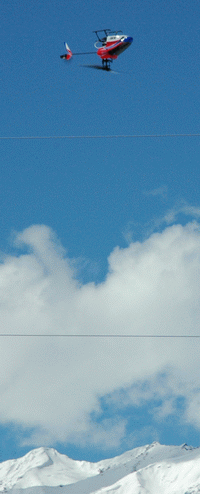
The main reason I purchased the mCP was to practice sport flight on something inexpensive and hopefully indoors when poor weather kept me inside.
Should you crash into some immovable object, the Blade mCP S has very good power protection circuitry instantly killing the power the second they detect a high current spike.
This works very well at reducing component damage should you hit something with the rotors at power. That said, it's ALWAYS best to power down or hit throttle hold with any micro if a crash into something is imminent. It will reduce the energy of the impact substantially and give you more usable life out of your little bird.
I have found the weighted blades that come with the mCP S also seem to be the best all round performers for most types of flying. This is pretty common with most flybarless systems - the overall cyclic performance/stability improves with some added blade mass, but that is subjective to how you like your cyclic feel - I need all the stability I can get!
Blade mCP S Brushless Main Motor Upgrade
This is a great upgrade! But first, a little history...
For those of us that had the original mCP X, and spent the money and time converting it to brushless with several aftermarket components; we all know it was not exactly cheap or easy.
Getting a motor and pinion gear and fitting them was no issue. It was getting the correct tiny brushless ESC along with the right throttle signal converter, wiring all that up, and extending the tail boom with a more powerful motor. That was the hard & pricey part!
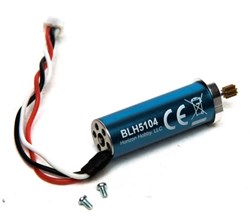 Blade makes upgrading to Brushless easy & affordable!
Blade makes upgrading to Brushless easy & affordable!I did this upgrade to my first mCP X as well, and it cost me almost $150 bucks by the time all was said and done - what a waste of money and time!
The little mCP flew so much better afterword however, I managed to justify the cost (not to the wife however who is obviously much smarter).
Blade however knew how many people wanted this feature so they have made a brushless upgrade both easy and inexpensive for the S version. You need to purchase the motor which already comes with the correct pinion gear (part number BLH5104). Cost is about $25 bucks.
You also need the combination ESC and throttle signal converter electronics (BLH5105). Again, about $25 bucks.
So for $50 bucks you can convert your mCP S to brushless if and when you wish. The stock tail rotor is also fine to keep since the boom is already longer, with a stronger motor and larger tail rotor right out of the box.
Once you have mastered flying your mCP S and want to get into aerobatic practice, I highly recommend this inexpensive upgrade.
Power is much smoother and there is more of it!
Blade mCP S Specifications
The blade mCP S comes in both RTF and BNF versions. The RTF version comes with a non-computerized 6 channel radio (MLP6DSM). The BNF version omits the radio, everything else is the same.
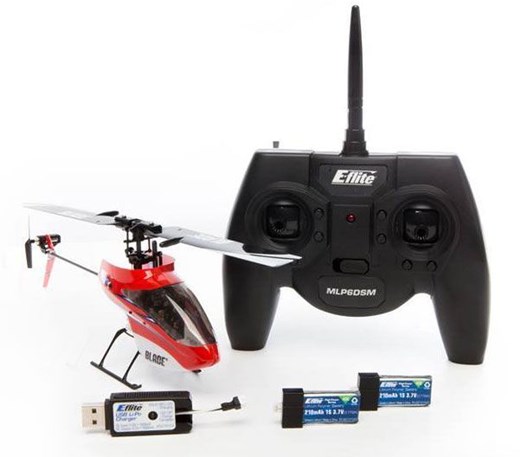 Blade mCP S RTF Package
Blade mCP S RTF PackageBlade mCP S Specifications
- Heli Classification: Ultra Micro Collective Pitch Helicopter
- Flying Environment: Indoors/Outdoors in calmer conditions
- Main Rotor Diameter: 9.4 in (240mm)
- Tail Rotor Dia: 1.6 in (40mm)
- Flying Weight: 1.7 oz (49g)
- Length: 9.25 in (235mm)
- Kit Type: Ready To Fly (RTF)
- Stabilization Type: Electronic Flybarless AS3X 3 Axis Gyro with SAFE 3 Axis Accelerometer
- Main Rotor Motor: Brushed (optional Brushless motor conversion available)
- Tail Rotor Motor Type: Brushed Coreless
- Radio Compatibility: All Computerized Spektrum DSMX 2.4 GHz
- RTF Version
- BNF Version
Final Thoughts
Having the Blade Nano, mCP, 130, and T-Rex 150X; I see the mCP S as the all round/all purpose CP micro. I quite honestly find I enjoy the Blade Nano indoors better and the Blade 130 & T-Rex 150X outdoors WAY better and really don't fly my mCP much anymore.
That said, if I only could pick one out of the four to practice CP flying skills both indoors and out, the mCP S is hard
to beat in that respect - especially once upgraded to brushless.
The obvious Blade mCP S downsides are the short flight times and the poor tail hold when performing aggressive type flying/not managing collective energy well.
For anyone who is learning to fly collective pitch and become a lot more comfortable & confident with collective pitch flying indoors or out and don't want to spend too much coin - the mCP S is a good valued micro CP RC helicopter to consider.
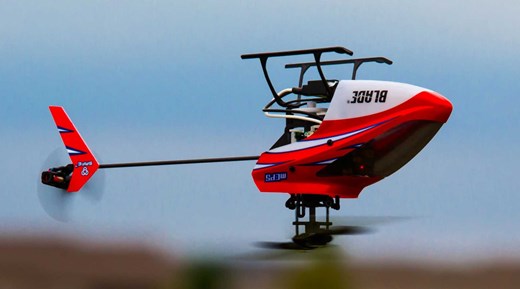 Blade mCP S Hovering Inverted
Blade mCP S Hovering Inverted





